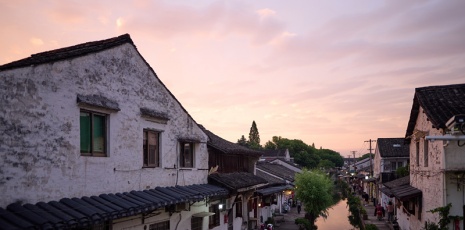
An aerial photo taken on April 20, 2023, shows the Hangzhou Future Sci-Tech City in Hangzhou, East China's Zhejiang province. [Photo/Xinhua]
The host cities of the Hangzhou Asian Games, which will take place from Sept 23 to Oct 8 in Hangzhou and five other cities in Zhejiang province, have tapped into state-of-the-art communication technologies such as the 5G-Advanced and passive internet of things, to ensure a smart Asian Games.
A globally leading communication technology, 5G-Advanced can facilitate data transfer up to 10 times faster than standard 5G gigabit networks. According to the organizing committee of the Hangzhou Asian Games, this technology has been deployed in intelligent connected vehicles and smart venue operations.
The first demonstration of a 5G-A 10-gigabit network has been installed along the route connecting the Hangzhou Olympic Sports Center and the Asian Games Village, it said.
Passive IoT is another communication technology widely applied to achieve smart management during the Asian Games, the organizing committee said.
The Hangzhou Esports Center will use passive IoT tags to monitor environmental temperatures and humidity in real time. The technology will also be employed in the Asian Games Village to facilitate the tracking of logistics vehicles and warehouse management. These tags will assist in asset inventory management and enable the monitoring of valuable assets, such as vehicles and electric bicycles, to prevent theft.
Autonomous driving technology has been applied to driverless buses, which will shuttle back and forth between the Deqing Sports Center Gymnasium and the Deqing Geographic Information Town Basketball Court.
Above all, a 5G network capable of ensuring tens of thousands of people can surf the internet at the same time without network lag at the Hangzhou Olympic Sports Center Stadium has been one of the top concerns of event organizers.
As the main venue of the Hangzhou Asian Games, the stadium, also known as the Big Lotus, will host the opening and closing ceremonies, and track and field competitions.
Covering 229,000 square meters, the Big Lotus, which consists of 28 large petals and 27 small petals, can house more than 80,000 people. Considering its special structure and huge user density during the Games, the technical team responsible for the venue's network and communication has been working on feasible solutions since 2019, when the stadium was put into use.
Li Qianxing, director of venue network and communication support, recalled that in 2019, the Big Lotus hosted an event with 60,000 people.
"We found that the original network communication equipment could not support the entire stadium," Li said, adding he expected the demand for network usage to rise sharply due to the prevalence of 5G mobile phone users.
"The need to build an intelligent, elastic network for the stadium was imperative," Li said.
"From 2022 to the present, we have repeatedly conducted stress tests on the network system in a full-scale environment and continuously improved it," Li said.
In the months leading up to the Games, Li said his team had increased the frequency of drills.
It is understood that based on the 5G network, intelligent game viewing applications will also be promoted and used during the Asian Games.
Li said the audience can use the 5G smart game-viewing application to achieve immersive game viewing, and can switch between the athletes' perspective and the coaches' seats perspective to achieve all-around and enjoyable viewing at any location on the field.
"Even at home, they can experience the scene and watch a wonderful Asian Games," Li said.









